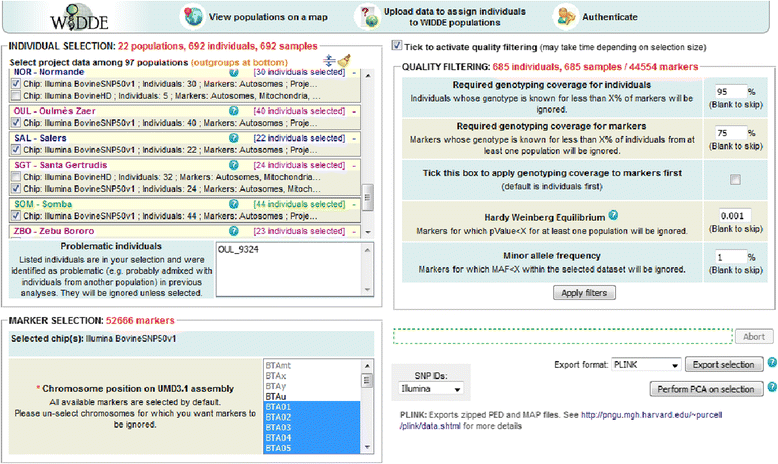WIDDE: a Web-Interfaced next generation database for genetic diversity exploration, with a first application in cattle
- PMID: 26573482
- PMCID: PMC4647285
- DOI: 10.1186/s12864-015-2181-1
WIDDE: a Web-Interfaced next generation database for genetic diversity exploration, with a first application in cattle
Abstract
Background: The advent and democratization of next generation sequencing and genotyping technologies lead to a huge amount of data for the characterization of population genetic diversity in model and non model-species. However, efficient storage, management, cross-analyzing and exploration of such dense genotyping datasets remain challenging. This is particularly true for the bovine species where many SNP datasets have been generated in various cattle populations with different genotyping tools.
Description: We developed WIDDE, a Web-Interfaced Next Generation Database that stands as a generic tool applicable to a wide range of species and marker types ( http://widde.toulouse.inra.fr). As a first illustration, we hereby describe its first version dedicated to cattle biodiversity, which includes a large and evolving cattle genotyping dataset for over 750,000 SNPs available on 129 (89 public) different cattle populations representative of the world-wide bovine genetic diversity and on 7 outgroup bovid species. This version proposes an optional marker and individual filtering step, an export of genotyping data in different popular formats, and an exploration of genetic diversity through a principal component analysis. Users can also explore their own genotyping data together with data from WIDDE, assign their samples to WIDDE populations based on distance assignment method and supervised clustering, and estimate their ancestry composition relative to the populations represented in the database.
Conclusion: The cattle version of WIDDE represents to our knowledge the first database dedicated to cattle biodiversity and SNP genotyping data that will be very useful for researchers interested in this field. As a generic tool applicable to a wide range of marker types, WIDDE is overall intended to the genetic diversity exploration of any species and will be extended to other species shortly. The structure makes it easy to include additional output formats and new tools dedicated to genetic diversity exploration.
Figures




References
Publication types
MeSH terms
LinkOut - more resources
Full Text Sources
Other Literature Sources
Research Materials

